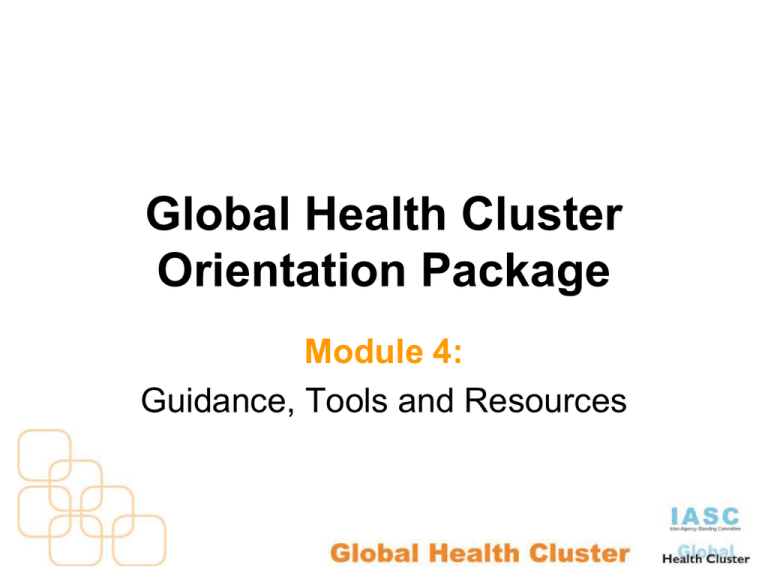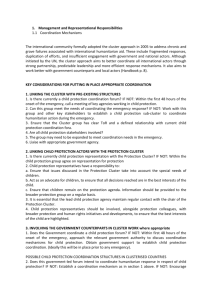Global Health Cluster Orientation Package Module 4
advertisement

Global Health Cluster Orientation Package Module 4: Guidance, Tools and Resources Module 4: Learning Objectives On completion of this module participants will be aware of: • The tools and guidance which have been developed by the Global Health Cluster • The aims and practical applications of these tools and guidance 3 The Health Cluster Guide The Global Health Cluster has developed a practical guide for country-level implementation of the Health Cluster Available in English and French: www.who.int/hac/global_health_cluster/guide • online • hard copy • CD/ROM The Health Cluster Guide • Country level: outlines how the Health Cluster Lead Agency(WHO) and partners can work together during humanitarian crises • Highlights the key principles of humanitarian health action • Explains how working in partnership can increase the effectiveness and efficiency of health interventions 5 The Health Cluster Guide (2) Each Chapter: • Highlights key points • Summarises activities to be carried out and issues to consider • Lists and explains the tools and guidelines available • Indicates challenges likely to be faced • Provides practical hints and references for further guidance The Health Cluster Guide http://www.who.int/hac/global_health_cluster /guide/en/index.html The Health Cluster Guide Content Chapter 1: Role and functioning of a health cluster Chapter 2: Assuring effective coordination Chapter 3: Assessing and monitoring the health situation Chapter 4: Analysing and prioritizing Chapter 5: Developing a strategy; planning Chapter 6: Ensuring standards Chapter 7: Advocacy and resource mobilization Chapter 8: Monitoring cluster performance Chapter 9: Standard services and indicator list The Health Cluster Guide Annexes A. Generic Terms of Reference for Sector Leads B. Types and phases of assessment in a humanitarian crisis C. General principles for all data collection activities D. Drawing up an assessment plan, schedule and budget E. Stakeholder analysis F. Priority Cross-cutting Issues G. Analysing response options; examples of negative effects H. SPHERE standards Core health indicators Four categories : • Health Resources Availability (A 1-8) • Health Services Coverage (C 1-6) • Risk Factors (R 1-7) • Health Outcomes (0 1-5) Total of 26 suggested indicators 10 Assessing the health situation Information is needed on: • Health status and risks • Resources availability • System performance Assessing the health situation (2) Data and analysis should be: • Regularly up-dated • Collected with the maximum possible involvement of national and sub-national health authorities and other partners • Based on common, gender-sensitive indicators, standards, protocols and case definitions • Disseminated in time to inform decisions on the planning and management of response activities Core aspects of information needs Health Status and Risks Health Resource and Availability Health System Performance • Current health status of affected population groups (mortality & morbidity & major causes) & health risks (e.g. potential outbreaks) Initially • facilities • personnel • supplies and services state and non state • Coverage and quality of available services • Access for all population groups to services and their utilisation of services Later • all above & • other health system components (management, finance, etc.) 13 Tools for data collection & analysis 1. Initial Rapid Assessment (IRA) 2. Health Resource Availability and Mapping System (He RAMS) 3. Early Warning and Response System (EWARS) and the HANDS software produced by the Health and Nutrition Tracking Service 4. UNHCR Health Information System (HIS) 14 IRA tool: background Recent experience of inter-agency, inter-cluster rapid assessments in a number of countries has shown: • Extremely haphazard and ill-prepared needs assessments • No standard tool available • Multiple assessments/surveys with variety of methodologies from different agencies 15 IRA tool (2) • A multi cluster/multi sectoral tool • Collects, compiles and analyses information on: the health status of the population the determinants of health (nutrition, water supply, sanitation, etc.) current health services characteristics (coverage, resources, services available, access, etc.) • Should ideally be carried out within 72 hours of the onset of a crisis situation IRA tool (3) • Developed jointly by global health, nutrition, WASH and shelter clusters • Should be conducted jointly with Health, WASH, Nutrition & Shelter clusters - with Health Cluster or Inter-cluster leadership • May need minimal customisation at country level 17 IRA tool (4) The tool includes: • • • • Guidelines Assessment form for data collection An Aide Memoire for field teams Data entry and analysis template & software 18 Health resources & services availability mapping system (HeRams) • Promotes and supports good practices in mapping the availability of the health resources and services in emergencies • Strengthens the Health Cluster's informed decision making and coordination HeRAMS (2) HERAMS is a software-based information system. Developed to support the collection, collation and analysis of information on the available health resources and services in emergencies. HeRAMS (3) There are two versions of HeRAMS: • The Initial He RAMS (“i-He RAMS”) used during the first few days/weeks of an acute crisis to record and analyse aggregate data on the numbers of active health partners, numbers of functioning health facilities by type, numbers of key health staff (doctors, nurses, midwives), and the level of health services available by administrative level (e.g. district, sub-district) HeRAMS (4) • The (“Full”) HeRAMS should be used as soon as feasible and then throughout the duration of a crisis to record and analyse data on the available resources and the specific services at each “point of delivery”. HeRams data Structure Metadata Point of Delivery Modality of Delivery Health Personnel Health Services Additional Modules Early Warning and Response System EWARS • Weekly routine reporting of health data from health facilities • Immediate reporting of specific critical conditions • May be built around pre-existing surveillance systems 26 Health information and Nutrition Tracking System HANDS • Events Analysis & Nutrition Data Surveillance • Developed by Health & Nutrition Tracking Service (HNTS) based in Geneva • An Excel application which can be used to capture and analyse data generated by EWARS 27 Health Information System (HIS) • A UNHCR developed system to support the collection of standardised, facility-based surveillance data in refugee settings • Promotes using core Global Health Cluster indicators in humanitarian crises 28 Information needs Information for HCC and HC partners is needed on: Health Status of Affected Populations Health Resources Availability Health System Performance Initial Rapid Assessment Health Resources Availability Mapping System Routine reporting, ad hoc surveys, HIS, etc. Tools available (IRA) … for the collection, collation and analysis of this information: Early Warning Systems (HINTS) (HeRAMS) Desired situation … expressed in terms of specific programmatic targets, international standards, benchmarks, etc. Targets – Benchmarks – Thresholds – etc. Identification of GAPS in the Humanitarian Response Global Health Cluster Position Papers “Removing User Fees for Primary Health Care Services During Humanitarian Crises” Provides guidance for the removal of user fees for the provision of primary health care services during humanitarian crises. GHC Position Papers (2) “Civil-military Coordination in Humanitarian Situations” Provides insight to the problematic situation that many partners face while working at country level and to provide guidance on how to coordinate with military actors in a humanitarian health response Module 4: Key Messages (1) • The Health Cluster Guide provides stakeholders with information and resources for country level implementation • The 26 suggested Core Health Indicators have been developed to assist the decision making at country level (including coordination, advocacy and fund raising) Module 4: Key Messages (2) • The Initial Rapid Assessment (IRA) tool is a multi cluster/multi sectoral tool which provides essential information in the first phase of an emergency • Health Resource Availability Mapping System (He Rams) is a framework for the assessment and monitoring of health resources and services availability Module 4: Key Messages (3) The Health Cluster position paper: “Removing User Fees for Primary Health Care Services During Humanitarian Crises” states that user fees should not be charged for primary health care services during humanitarian crises Resources • Health Cluster Guide http://www.who.int/hac/global_health_cluster/ guide/en/index.html • Tools – in English and French http://www.who.int/hac/global_health_cluster/ guide/tools/en/index.html Resources (2) • Gap Guidance Materials “Assisting the Health Sector Coordination Mechanism to Identify and fill gaps in the Humanitarian Response” IASC/GHC Sub Group on Management and Coordination • Position Paper on User fees http://www.who.int/hac/global_health_cluster/a bout/policy_strategy/EN_final_position_paper_ on_user_fees.pdf Discussion & Questions





